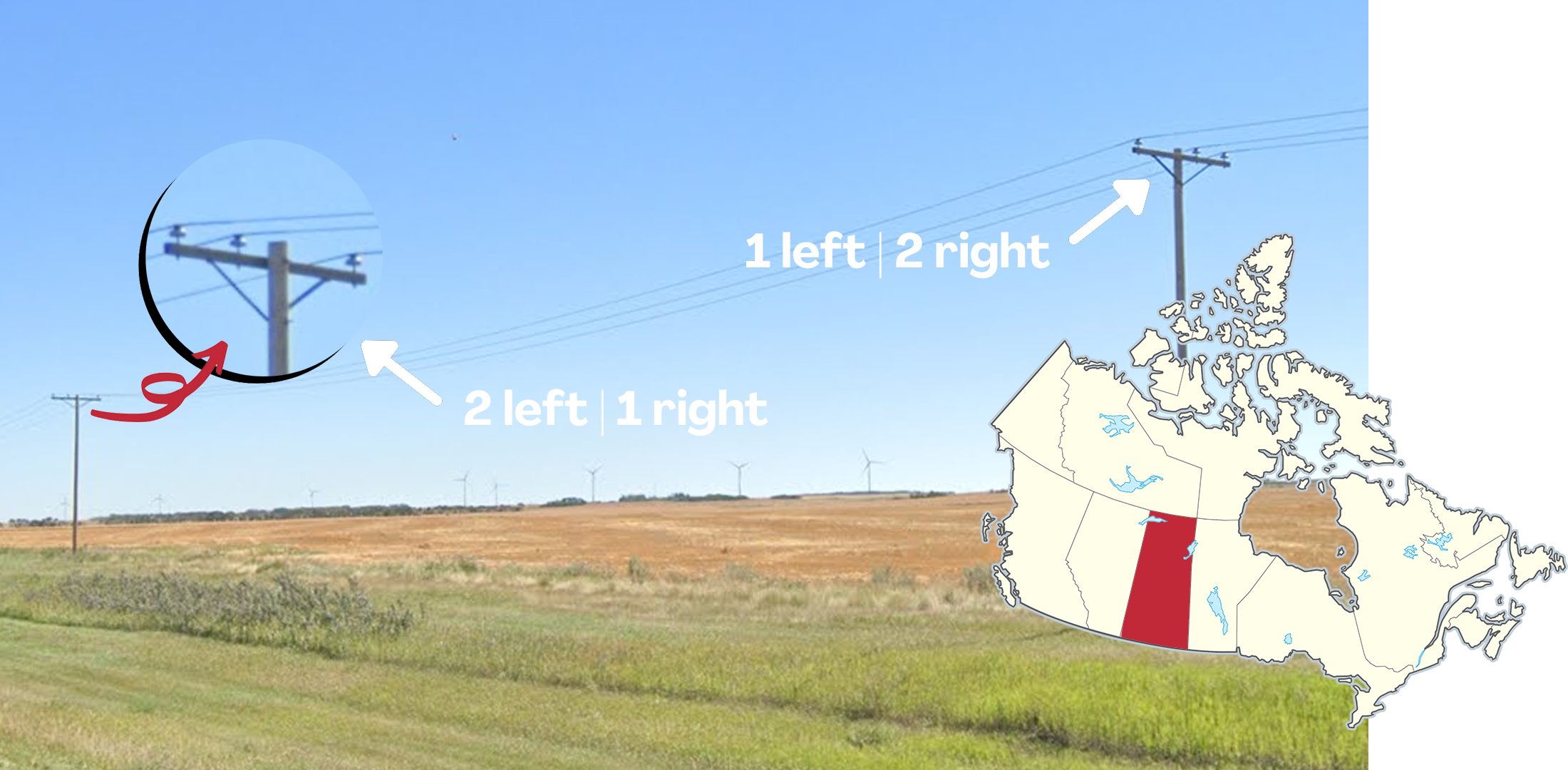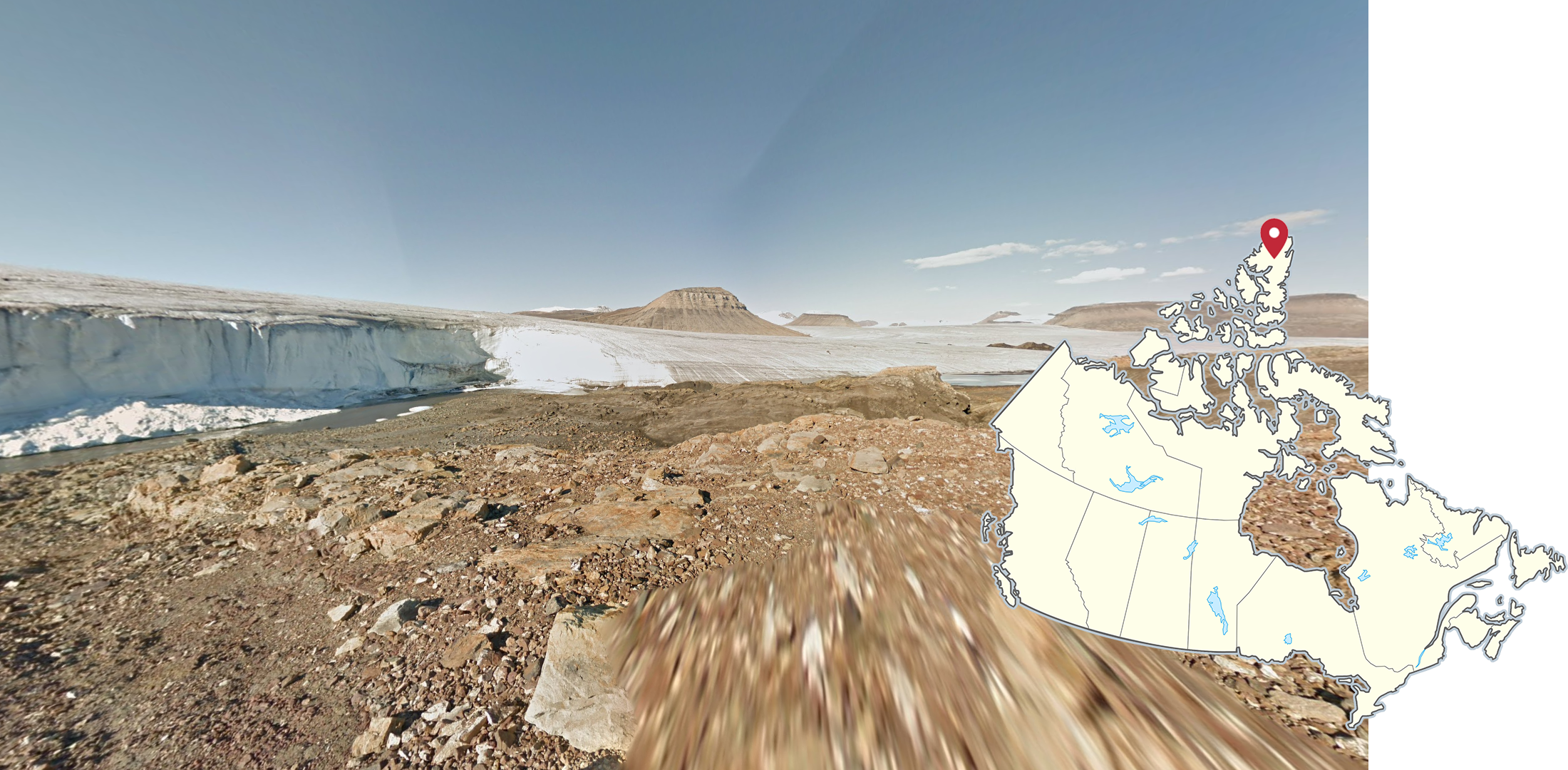
Canada
The English-speaking parts of Canada use British English spelling (e.g. centre; colour). In addition, Canada mostly uses the metric system. For example, speed is measured in kilometres per hour.
NOTE: This is useful to distinguish between the US, where American English spelling and (usually) the imperial system are used. For example, the US measures speed in miles.
Canada has a fair amount of Generation 2 coverage, especially in rural or remote areas. Generation 2 can be recognized by the big circular car blur and the halo-like colour distortion in the sky.
NOTE: Generation 2 is very rare in the US. If you are between Canada and the US, and the location is in Generation 2, you are much more likely to be in Canada.
Canada also has Generation 4 “smallcam” coverage, which is mounted lower than regular Generation 4 and has a relatively big circular blur with a small protrusion at the front. The blur can also be fully transparent, making it harder to spot. When the car isn’t blurred properly, you will usually see a mirror sticking out on the right side.
Canada uses the word ‘maximum’ on speed signs. Because speed is measured in kilometres instead of miles, the numbers tend to be higher than the US which can be identifiable from afar.
NOTE: The US uses the words ‘speed limit’ on such signs. In addition, speed limits ending with 5 are more common in the US, and the ‘speed limit’ text takes up two lines versus one for ‘maximum’ in Canada.
Each province has its own unique licence plates, some recognizable from afar even when blurred. Multiple provinces do not require front plates, which can be useful when deciding between provinces.
NOTE: Since 2019, front plates are no longer required in New Brunswick. However, you should still expect to see them in older coverage. As well, all commercial vehicles in Newfoundland and Labrador are required to use front plates, and so it is possible to see them on vans and pickup trucks.
You can click on the image to enlarge it.
French is the majority language in Québec and parts of New Brunswick.
NOTE: At the federal level, French has official status alongside English, so you can sometimes find bilingual signs in other parts of Canada. In addition, French is also spoken in several communities in Nova Scotia, Ontario and Manitoba.
Infrastructure
Some provinces have unique speed signs.
Ontario speed limit signs may have a black section on the bottom with the words ‘km/h’ or ‘begins’ written in white.
British Columbian signs also include the ‘km/h’ but lack the black section.
Québec can sometimes have French on their speed limit signs.
You can click on the image to enlarge it.
Alberta has a unique black and white bollard that is often found at intersections. It has a cylindrical shape and two black bands that wrap all the way around. It is one of the most useful Canadian bollards to learn because it appears so frequently.
NOTE: Some Alberta bollards have a yellow band between the two black bands, instead of a white one. Blue bands can also rarely be seen, particularly in and around Calgary, while green bands are rarely seen in and around Edmonton.
Manitoba uses black and grey painted bollards. Most of the time an orange stripe will be present below the grey one.
Wooden, rectangular bollards of this form are typically found further north in Manitoba
NOTE: Bollards in this format with just a black top are seen in Manitoba and Saskatchewan.
British Columbia has black-and-white bollards with a thin, slightly curved shape. It is most commonly found on Vancouver Island, but can be found all throughout the province.
NOTE: They can look superficially similar to the Alberta bollard. However, the thin shape and the wider spacing of the two black bands should help you tell them apart.
You will often find these yellow fire hydrant markers atop signposts in Québec.
In Québec City these markers will usually have a blue rectangle and markers in Trois-Rivières are distinctly small.
NOTE: Sometimes the markers will have different colours. Beware that Edmundston, in New Brunswick, uses these too.
The transformers on poles will face the road in British Columbia and New Brunswick, while in other provinces, it will be parallel with the wires.
These distinctive pole tops are most commonly found in Ontario. They have two insulators to the side, and one on top. The side insulators are affixed to the pole with a distinct attachment. Sometimes, multiple of them can be stacked on top of each other.
NOTE: They can occasionally appear in British Columbia, Nova Scotia, or other provinces more rarely.
Rural roads in Alberta are numbered sequentially. This makes it easy to figure out your exact location using just a road sign.
Township roads (Twp Rd) run east to west. Their numbers increase the more north you go.
Range roads (Rge Rd) run north to south. Their numbers increase the more west you go. These numbers reset a couple of times.
This infographic shows which numbers are found where. You need to multiply the numbers on the grid by 10 to get the road numbers. For example, the junction in the image example is found just north of Red Deer.
NOTE: Similarly named roads can also sometimes be seen in Saskatchewan, however they are more common in Alberta.
In Newfoundland and Labrador, most wooden posts on guardrails have this pyramid shaped top. Occasionally, you can spot them on standalone posts and signposts as well.
Ontario uses distinct orange and black striped traffic cones.
Québec, on the other hand, has unique orange and white striped traffic cones.
Québec is the only Canadian province that uses red and white chevrons.
NOTE: The rest of Canada uses the classic yellow and black chevrons.
Landscape
Yukon has a very northern, boreal landscape that is mostly hilly, sometimes with large mountains in the distance. Coniferous trees line the roads and the further north you go, the thinner and shorter the trees get. While this region recently got a lot of new Generation 4, older Generation 2 coverage is still very common.
The Balsam Fir is a very common species of tree found in Newfoundland. It has a Christmas tree-like appearance.
NOTE: While most commonly found in Newfoundland, the Balsam Fir can also grow in other parts of Eastern Canada and the US. For an overview, see this map.
Miscellaneous
Canadian phone numbers start with a three-digit area code. Both landlines and mobile phones use the same area codes.
NOTE: Canadian phone numbers are formatted XXX XXX XXXX, with the area code being the first three digits. It is fairly common to see 7-digit numbers with the area code omitted.
You can click on the image to enlarge it.
Provincial flags appear decently often, so it is worth learning them. The Fleurdelisé of Québec in particular is very common.
You can click on the image to enlarge it.
Bins made of wood planks can be seen on Newfoundland driveways. These are most commonly octagonal, however they can have other shapes.
NOTE: Although they are most common in Newfoundland, they can also sometimes be seen in other provinces, such as New Brunswick.
Acadia is a French-speaking cultural region in the Canadian Maritimes. It does not have clearly defined borders, but is usually understood to at least include north and east New Brunswick. It has its own flag, which is very commonly seen in this region. The flag is a French-style tricolour with a yellow star in the blue band.
NOTE: There are some isolated Acadian communities in Nova Scotia and Prince Edward Island (shaded pink on the minimap).
The Dempster Highway (road numbers 5 and 8) connects the Klondike Highway (road number 2) in Yukon with the remote town of Inuvik in the Northwest Territories.
It is very recognizable: it is an unpaved road with Generation 2 coverage, dark brown soil, and a tundra landscape with short trees. It is mostly hilly and mountainous, but the section between Fort McPherson and Inuvik is flat. Closer to Inuvik, the weather gets cloudy.
Route 430 on Newfoundland has Generation 3 coverage and runs in a roughly south-southwest to north-northeast direction. It is located in a remote and sparsely populated part of the island. On many sections of the road, the coast is visible to your west. To your east, you will usually see low pine tree forests, and occasionally an imposing wall of mountains in the far distance.
Remote towns and trekkers
Sanikiluaq is a remote town situated in Hudson Bay. This snowy town was covered by a snowmobile whose driver wore a dark brown coat.
NOTE: Snowmobile coverage can be found outside the town on the ice-covered sea, where the driver is not visible.
Nain is a small town on the Northeastern coast of Labrador. The town features colourful wooden houses, and trees in and around the town. To the north, a big hill is usually visible. And to the south, rocky cliffs can be seen on the other side of the bay. Additionally, kids can sometimes be seen walking beside the trekker.
The northernmost Google Street View coverage in the world is a trekker on Ellesmere Island in northern Nunavut. It shows a glacier in a rocky, desolate landscape that is devoid of any vegetation.
NOTE: This coverage is sometimes used in maps to improve and standardise the scoring range. As a result, you might encounter this trekker in competitive maps like ACW, despite it not being pinpointable.
GeoGuessr’s own official maps are not very good, for a variety of reasons. Plonk It recommends you play these maps instead:
A Balanced Canada (map link) - 52493 locations, not pinpointable.
In addition, here are some resources to help you practise Canada:
Plonk It Canada (map link) - This map contains locations for practising each meta in the Plonk It Canada guide from step 2 to 3.
























































































